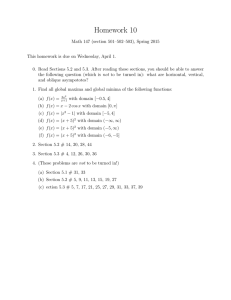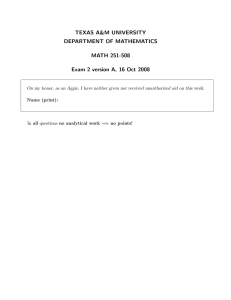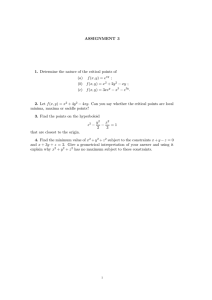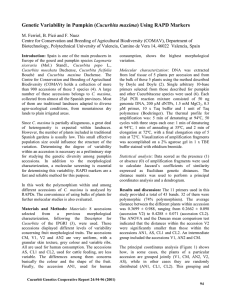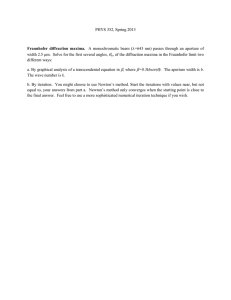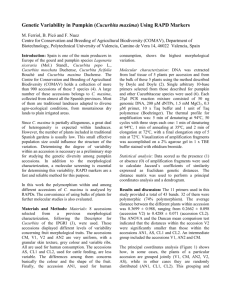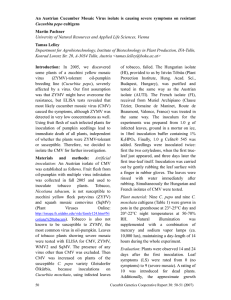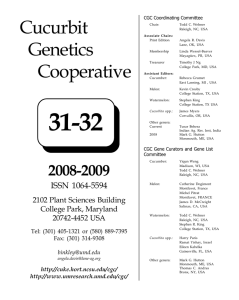Cucurbita maxima Menahem Edelstein and Menahem Edelstein
advertisement
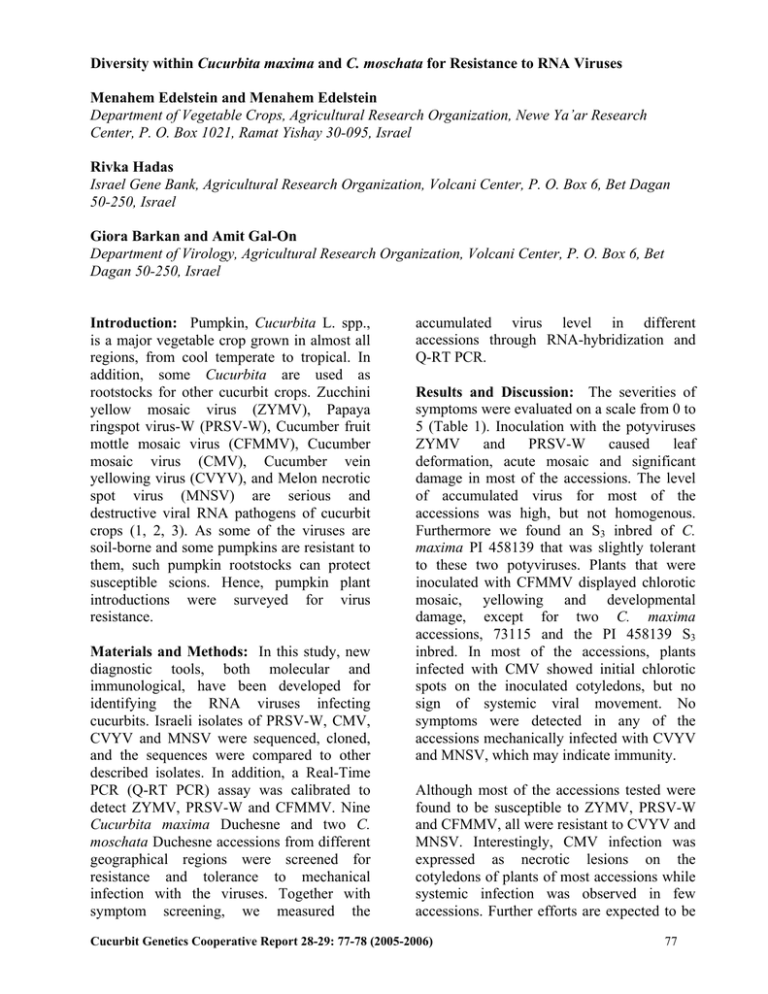
Diversity within Cucurbita maxima and C. moschata for Resistance to RNA Viruses Menahem Edelstein and Menahem Edelstein Department of Vegetable Crops, Agricultural Research Organization, Newe Ya’ar Research Center, P. O. Box 1021, Ramat Yishay 30-095, Israel Rivka Hadas Israel Gene Bank, Agricultural Research Organization, Volcani Center, P. O. Box 6, Bet Dagan 50-250, Israel Giora Barkan and Amit Gal-On Department of Virology, Agricultural Research Organization, Volcani Center, P. O. Box 6, Bet Dagan 50-250, Israel Introduction: Pumpkin, Cucurbita L. spp., is a major vegetable crop grown in almost all regions, from cool temperate to tropical. In addition, some Cucurbita are used as rootstocks for other cucurbit crops. Zucchini yellow mosaic virus (ZYMV), Papaya ringspot virus-W (PRSV-W), Cucumber fruit mottle mosaic virus (CFMMV), Cucumber mosaic virus (CMV), Cucumber vein yellowing virus (CVYV), and Melon necrotic spot virus (MNSV) are serious and destructive viral RNA pathogens of cucurbit crops (1, 2, 3). As some of the viruses are soil-borne and some pumpkins are resistant to them, such pumpkin rootstocks can protect susceptible scions. Hence, pumpkin plant introductions were surveyed for virus resistance. Materials and Methods: In this study, new diagnostic tools, both molecular and immunological, have been developed for identifying the RNA viruses infecting cucurbits. Israeli isolates of PRSV-W, CMV, CVYV and MNSV were sequenced, cloned, and the sequences were compared to other described isolates. In addition, a Real-Time PCR (Q-RT PCR) assay was calibrated to detect ZYMV, PRSV-W and CFMMV. Nine Cucurbita maxima Duchesne and two C. moschata Duchesne accessions from different geographical regions were screened for resistance and tolerance to mechanical infection with the viruses. Together with symptom screening, we measured the accumulated virus level in different accessions through RNA-hybridization and Q-RT PCR. Results and Discussion: The severities of symptoms were evaluated on a scale from 0 to 5 (Table 1). Inoculation with the potyviruses ZYMV and PRSV-W caused leaf deformation, acute mosaic and significant damage in most of the accessions. The level of accumulated virus for most of the accessions was high, but not homogenous. Furthermore we found an S3 inbred of C. maxima PI 458139 that was slightly tolerant to these two potyviruses. Plants that were inoculated with CFMMV displayed chlorotic mosaic, yellowing and developmental damage, except for two C. maxima accessions, 73115 and the PI 458139 S3 inbred. In most of the accessions, plants infected with CMV showed initial chlorotic spots on the inoculated cotyledons, but no sign of systemic viral movement. No symptoms were detected in any of the accessions mechanically infected with CVYV and MNSV, which may indicate immunity. Although most of the accessions tested were found to be susceptible to ZYMV, PRSV-W and CFMMV, all were resistant to CVYV and MNSV. Interestingly, CMV infection was expressed as necrotic lesions on the cotyledons of plants of most accessions while systemic infection was observed in few accessions. Further efforts are expected to be Cucurbit Genetics Cooperative Report 28-29: 77-78 (2005-2006) 77 focused on C. maxima PI 458139 because of its resistance to CFMMV and lower susceptibility to ZYMV and PRSV-W, for use in classical breeding as well as for investigating the mode of inheritance of its resistance to CFMMV Literature Cited: 1. Antignus, Y., Y. Wang, M. Pearlsman, O. Lachman, N. Lavi, and A. Gal-On. 2001. Biological and molecular characterization of a new cucurbit- infecting tobamovirus. Phytopathology 91: 565–571. 2. Diaz, J.A., C. Nieto, E. Moriones, V. Truniger, and M.A. Aranda. 2004. Molecular characterization of a melon necrotic spot virus strain that overcomes the resistance in melon and nonhost plants. Mol. Plant-Microbe Interact. 17: 668–675. 3. Nameth, S.T., J.A.Dodds, A.O. Paulus, and F.F. Laemmlen, 1986. Cucurbit viruses in California: an ever-changing problem. Plant Dis. 70: 8–11. Table 1. Severity of symptoms in eleven accessions infected with ZYMV, PRSV-W, CFMMV, CMV, CVYV, and MNSV. Cucurbita sp. IGBz Number ZYMV PRSV-W CFMMV CMVy CVYV MNSV 73079 4x 4 4 co 0 C. maxima 5 5 1 3-sy 0 C. moschata 59329 73085 3 3 3 1 0 C. maxima 73088 3 3 3 co 0 C. maxima 59319 3 3 2 co 0 C. maxima 73112 3 3 3 1 0 C. maxima 73115 3 3 0 0 0 C. maxima 73081 4 4 5 1 0 C. maxima 5 4 2 0 0 C. moschata 73082 73113 4 3 4 co 0 C. maxima 2 2 0 co 0 PI w C. maxima z IGB = Israel Gene Bank (www.agri.gov.il/Depts/GeneBank/Genebank.html) y co = symptoms on cotyledons only; sy = systemic infection x 0 = none to 5 = severe symptoms w PI = S3 inbred of PI 458139 78 0 0 0 0 0 0 0 0 0 0 0 Cucurbit Genetics Cooperative Report 28-29: 77-78 (2005-2006)
